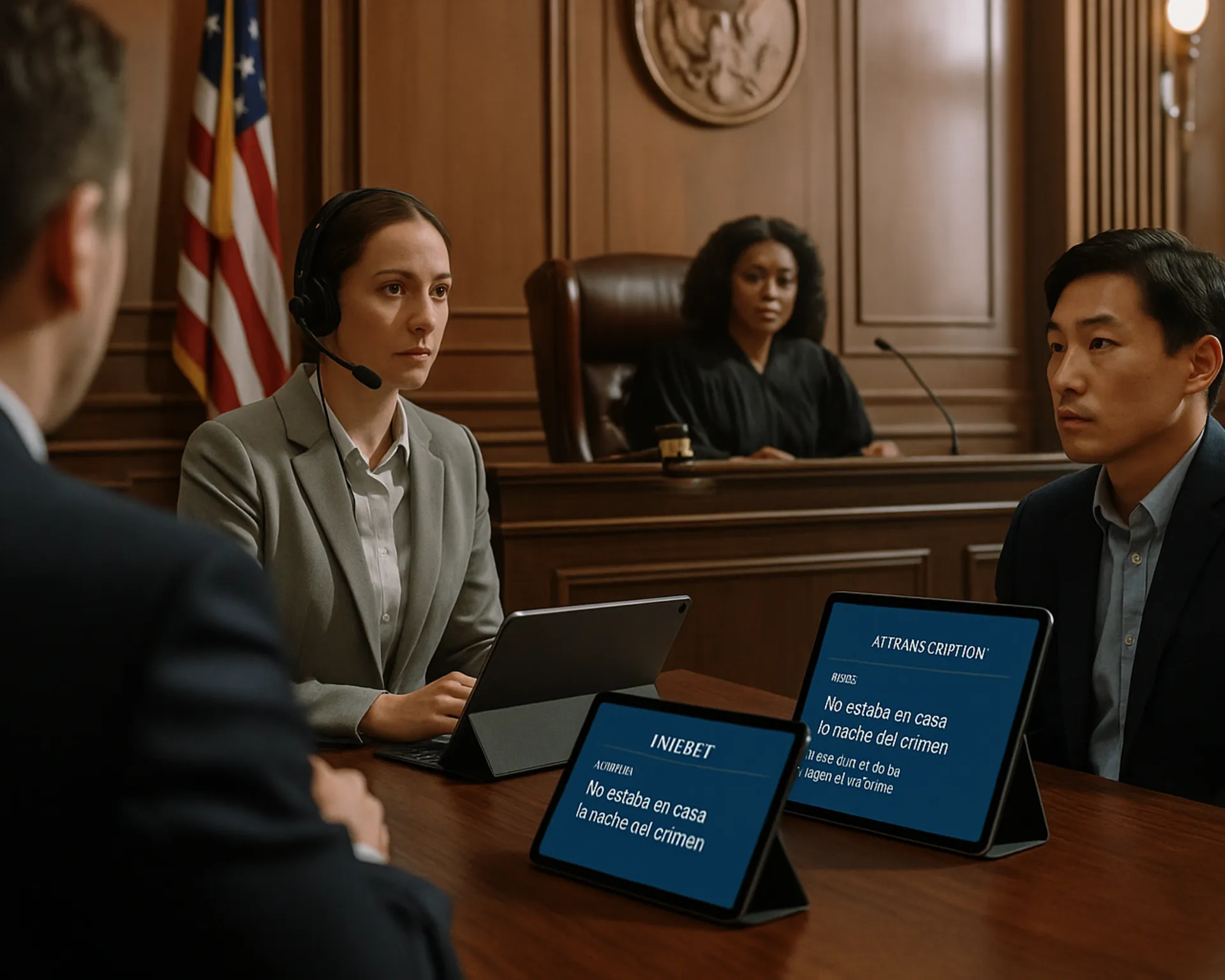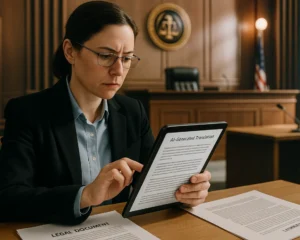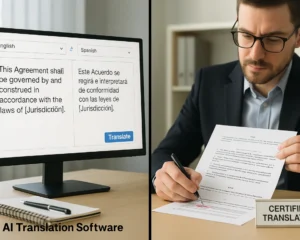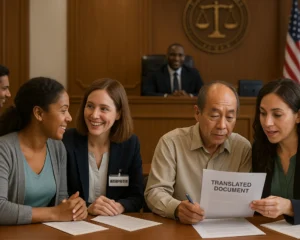In courtrooms across America, a quiet revolution is taking place. Artificial intelligence is stepping into one of the justice system’s most persistent challenges — providing accurate, timely language access for individuals with limited English proficiency. As courts grapple with a critical shortage of qualified translators and interpreters, AI-powered translation tools are emerging as both a promising solution and a source of heated debate. The question is no longer whether AI will play a role in legal translation, but how we can harness its power while preserving the human judgment that justice demands.
Orange County Superior Court in California stands at the forefront of this transformation. In 2025, the court developed its Court Application for Translation (CAT) system, powered by Microsoft Azure, to address the growing gap between language needs and available human translators. The results have been striking — 80% of Spanish translations were usable as-is, with only 17% requiring minor corrections and 3% containing major errors. Vietnamese translations, reflecting the scarcity of training materials for less common languages, achieved 57% accuracy with 39% needing minor adjustments.
These numbers represent more than technical achievement. They represent the difference between justice delayed and justice delivered, between individuals languishing in legal limbo and families moving forward with their lives. Yet they also underscore a fundamental truth — AI translation in courts is not about replacing human expertise, but about extending its reach.
The Language Access Crisis Driving Innovation
The United States faces a profound language access crisis in its court systems. According to Florencia Russ, CEO of Transcend Translations and an American Translators Association certified translator, “There’s a very high demand for translators and interpreters, and a shortage of both, particularly in less common language pairs and more rural areas.” This shortage creates substantial barriers to due process, potentially affecting individuals’ liberties, housing rights, and access to fundamental legal protections.
When qualified translators and interpreters are unavailable, hearings must be postponed. People spend more time in limbo — waiting for their day in court, unable to understand legal documents that determine their fate, caught in a system that speaks a language they cannot comprehend. This is not merely an inconvenience. It is a denial of the basic principle that justice must be accessible to all, regardless of the language they speak.
The National Center for State Courts (NCSC) and the Thomson Reuters Institute have recognized this crisis as a priority area for AI innovation. Through their partnership on AI Policy in the Law and Courts, they hosted webinars in June 2025 focused specifically on how AI can assist in translating written documents from one language to another. The emphasis on written translation — as opposed to spoken interpretation — reflects the immediate need for tools that can help courts process the mountain of legal documents that must be translated for non-English speakers to participate meaningfully in legal proceedings.
How AI Translation Works in Court Systems
Orange County’s CAT system demonstrates the thoughtful approach required for AI implementation in legal contexts. The court did not simply adopt off-the-shelf translation software. Instead, it developed a proprietary system trained specifically on court terminology and legal language. The system began with Spanish and Vietnamese — languages representing significant portions of Orange County’s limited English proficiency population — and trained the AI model using court-specific terms and phrases.
Deputy COO Blanca Escobedo explained that the court took a phased approach, starting with low-risk use cases such as translating educational materials and video scripts. This allowed the court to test the system, identify weaknesses, and build confidence before moving to higher-stakes documents. Later phases will focus on collaborative court essays and juvenile reports that typically exceed 100 pages — documents where AI’s speed advantage becomes particularly valuable.
The system operates with robust quality control mechanisms. Each AI-generated translation is reviewed by certified translators and scored to assess performance. This human-in-the-loop approach ensures that errors are caught before documents reach the public, while also providing data that helps improve the AI model over time. The court’s commitment to transparency includes clearly informing users when AI translation has been used through disclaimers on documents, maintaining open communication with staff and judiciary, and ensuring executive and judicial leadership understand and approve of the solutions being developed.
The Critical Role of Human Oversight
Former Minnesota State Supreme Court Chief Justice Bridget Mary McCormack captured the essential balance in her closing remarks at the NCSC webinar: “We are still at a stage where we want humans supervising this work, and we want humans who are certified and experts to be the ones supervising the work.” This statement reflects a fundamental understanding — AI translation tools are assistive technology, not autonomous systems.
Florencia Russ emphasized this point: “There has to be a human in the loop who has read and has done machine-translation post-editing to ensure that those translations are accurate” for effective use in a legal context. The stakes in legal translation are simply too high for unsupervised AI. A mistranslation in a custody document, a criminal complaint, or an eviction notice can have life-altering consequences. Human translators bring not only linguistic expertise but also cultural competency, contextual understanding, and the professional judgment to recognize when a translation requires additional research or consultation.
Balancing Efficiency with Accuracy and Trust
The promise of AI translation in courts extends beyond mere speed. Orange County’s CAT system resulted in significant reductions in translation expenditures and dramatic improvements in turnaround times. For courts operating under tight budgets and facing backlogs, these efficiency gains are not trivial. They represent the ability to serve more people, resolve cases more quickly, and allocate scarce resources more effectively.
[Image 3 here]
Yet efficiency means nothing if it comes at the cost of accuracy or public trust. Grace Spulak, Principal Court Management Consultant at NCSC, outlined the consequences of deploying AI translation without adequate safeguards: “If people do not feel the information they are getting from the courts is accurate and reliable, people will not trust the courts. They won’t look to the courts as a source of authority, and they won’t use information that they get from the courts.”
This concern about trust is particularly acute for communities that have historically faced language barriers in accessing justice. For immigrants, refugees, and linguistic minorities, the court system can already feel intimidating and alienating. The introduction of AI translation must be handled with sensitivity to these concerns, with clear communication about how the technology works, what its limitations are, and what human oversight is in place.
Essential Safeguards for AI Translation in Courts
The experts who participated in the NCSC webinar identified several essential mechanisms for maintaining public trust and ensuring quality in AI-assisted legal translation. Effective governance stands at the foundation — courts must have clear policies defining how AI will be used, what types of documents will be translated, and what limits exist on AI’s role. These protocols should establish guidelines for implementation, human review processes, and feedback mechanisms from both internal and external stakeholders.
Transparency forms another cornerstone. Courts must clearly disclose when AI translation has been used, whether through watermarks on documents, oral declarations, or other means. This transparency allows users to make informed decisions about whether they need additional human review or interpretation services. It also builds trust by demonstrating that courts are not hiding their use of AI but rather being forthright about both its capabilities and limitations.
Privacy and security considerations are equally critical. Orange County’s approach demonstrates best practices with an on-premises solution protected by firewalls, ensuring that confidential legal information remains secure. Reviewers sign confidentiality agreements to provide another layer of protection. These safeguards are essential given the sensitive nature of legal documents, which often contain personal information about individuals’ immigration status, criminal history, family situations, and financial circumstances.
The Path Forward for AI in Legal Translation
The Orange County Superior Court’s experience with its CAT system offers a roadmap for other courts considering AI-assisted translation. The key elements of success include starting with low-risk use cases, implementing robust human oversight, maintaining transparency about AI use, ensuring strong privacy and security protections, and committing to continuous quality assessment and improvement.
Courts modeling their efforts on Orange County’s approach will need to balance innovation with risk management. The goal is not to achieve perfect translation — even human translators do not achieve perfection — but rather to ensure that AI-assisted translations meet the standard of accuracy required for their intended use. Educational materials may tolerate a higher error rate than legal pleadings. Video scripts may be less sensitive than custody documents. Courts must make thoughtful decisions about where AI translation is appropriate and where human translation remains essential.
The future of AI in legal translation will likely involve increasingly sophisticated tools, better training on legal terminology, and improved handling of less common language pairs. Yet the fundamental principle will remain constant — technology serves justice, not the other way around. AI translation tools must be designed, deployed, and overseen in ways that enhance access to justice rather than creating new barriers or undermining public trust.
Justice That Speaks Every Language
The integration of AI-powered translation into court systems represents a pivotal moment in the ongoing struggle to make justice accessible to all. For too long, language barriers have denied individuals their day in court, prevented them from understanding their rights, and left them unable to navigate a legal system that should serve everyone equally. AI translation tools offer the potential to close this gap, to extend the reach of limited human translator resources, and to ensure that justice is not rationed based on which languages a court system can accommodate.
Yet this potential can only be realized through careful implementation that prioritizes accuracy, maintains human oversight, ensures transparency, and builds public trust. The Orange County Superior Court’s CAT system demonstrates that this balance is achievable. Courts can harness AI’s speed and efficiency while preserving the human judgment that legal translation demands. They can reduce costs and improve turnaround times while maintaining the quality standards that justice requires.
As more courts explore AI-assisted translation, they join a broader movement to leverage technology in service of access to justice. The question is not whether AI will play a role in legal translation — it already does. The question is whether courts will implement it thoughtfully, with adequate safeguards, or whether they will rush to adopt technology without considering its limitations and risks. The answer to that question will determine whether AI translation becomes a tool for expanding justice or another barrier for those already struggling to access it.
In the end, the goal remains unchanged — a justice system that speaks every language, that welcomes every person regardless of the tongue they speak, and that ensures meaningful access to legal protections for all. AI-powered translation, implemented with wisdom and care, can help us move closer to that ideal. But only if we remember that technology is a tool, not a replacement for the human commitment to justice that must animate every court system in a democratic society.




